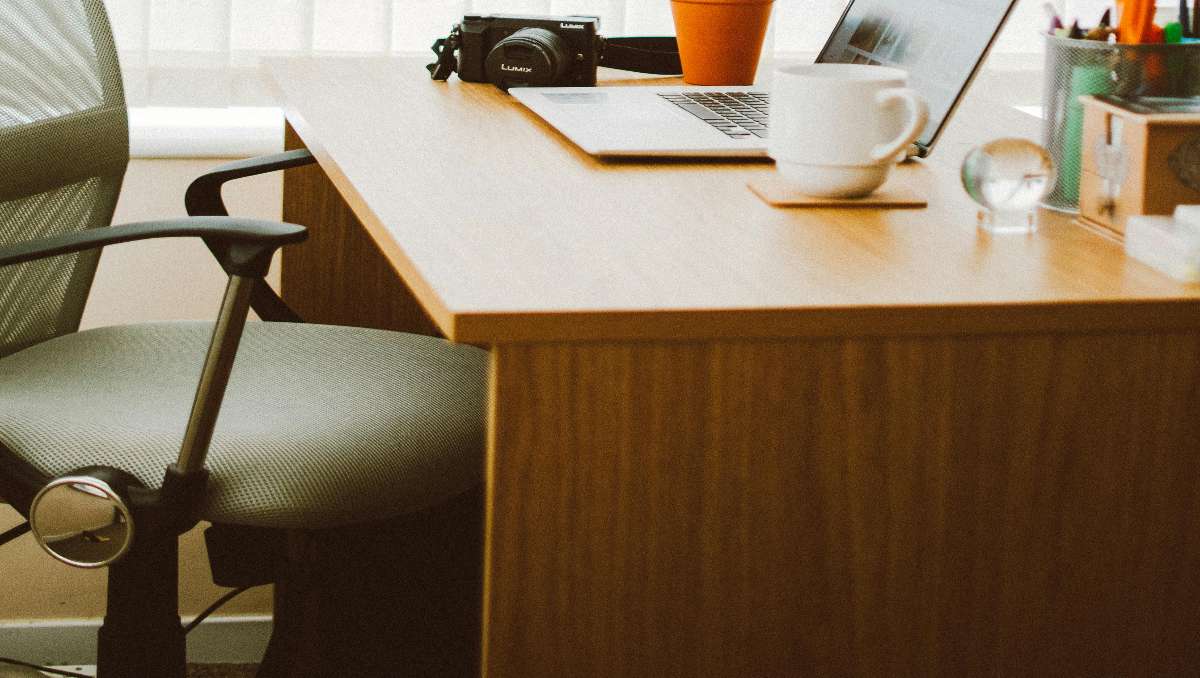Choosing the right desk is more than a matter of style; it’s about creating a foundation for focus, comfort, and productivity. A raw wood office desk stands apart from mass-produced options, offering authenticity, durability, and timeless beauty that elevates any workspace. With its natural elegance and warmth, each piece showcases unique grain patterns and textures, ensuring no two desks are exactly alike, and adding character that creates a personalized and inviting office environment.
Key Takeaways:
- A raw wood office desk is a sturdy, natural wood desk that shows unique grain patterns and lasts a long time, making it a stylish and eco-friendly choice for any workspace.
- Choosing the right wood type and properly maintaining it helps prevent damage like warping or cracking.
- Opting for sustainably sourced or reclaimed wood supports the environment while ensuring quality and longevity.
In this article, we’ll look at the best types of raw wood for furniture and explain why Amish artisans prefer them, while also sharing key factors to help you choose the right fit.
What is a Raw Wood Office Desk?
A raw wood desk is made from solid, natural wood that hasn’t been heavily processed or coated with heavy wood finishes. It’s usually just lightly sanded, which means the natural grain, knots, and even imperfections are still visible—and that’s part of the charm. Every piece is different, which gives your workspace a unique look you won’t get with mass-produced furniture.
Now, unlike desks made from MDF or particleboard, raw wood is solid. It’s strong, durable, and can handle years of use. And here’s a big plus: if it gets scratched or worn down over time, you can actually sand and refinish it. You can’t do that with most cheap desks. Plus, if the wood is sustainably sourced, you’re also making a more eco-conscious choice.
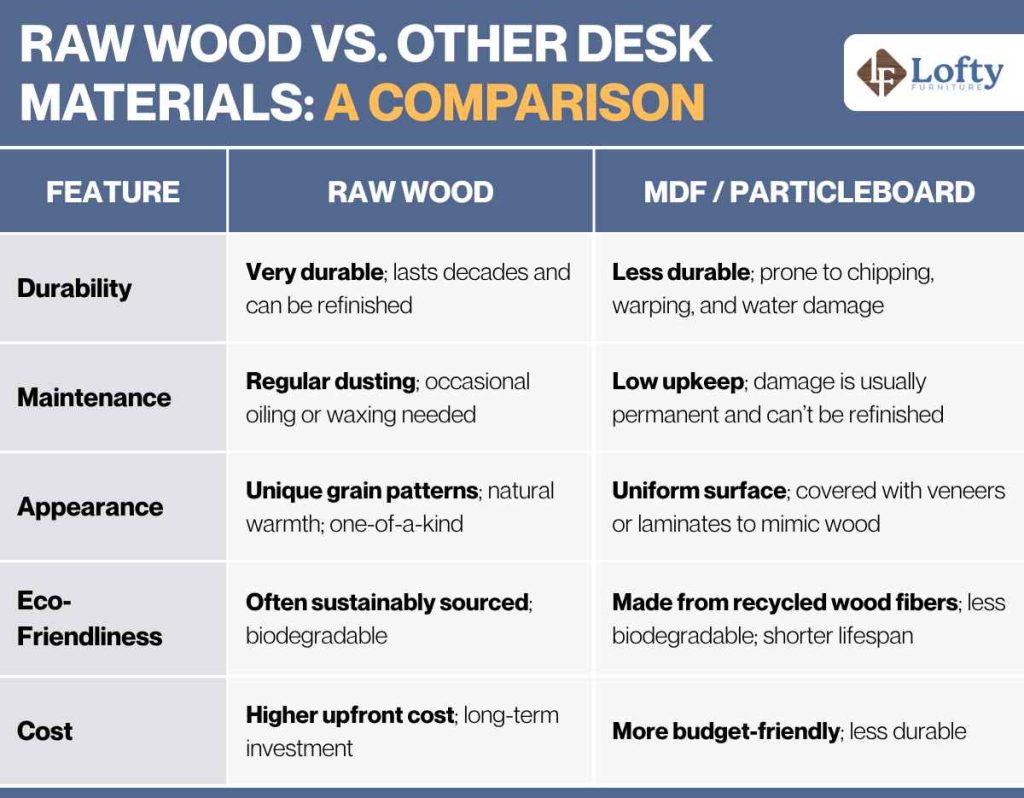
Common Types of Raw Wood Used in Office Desks
Not all raw wood desks are the same. The type of wood you choose affects both the look and the longevity of your workspace. Each variety brings its own strengths, from grain patterns to durability, and understanding these differences can help you pick the one that best fits your style and needs.
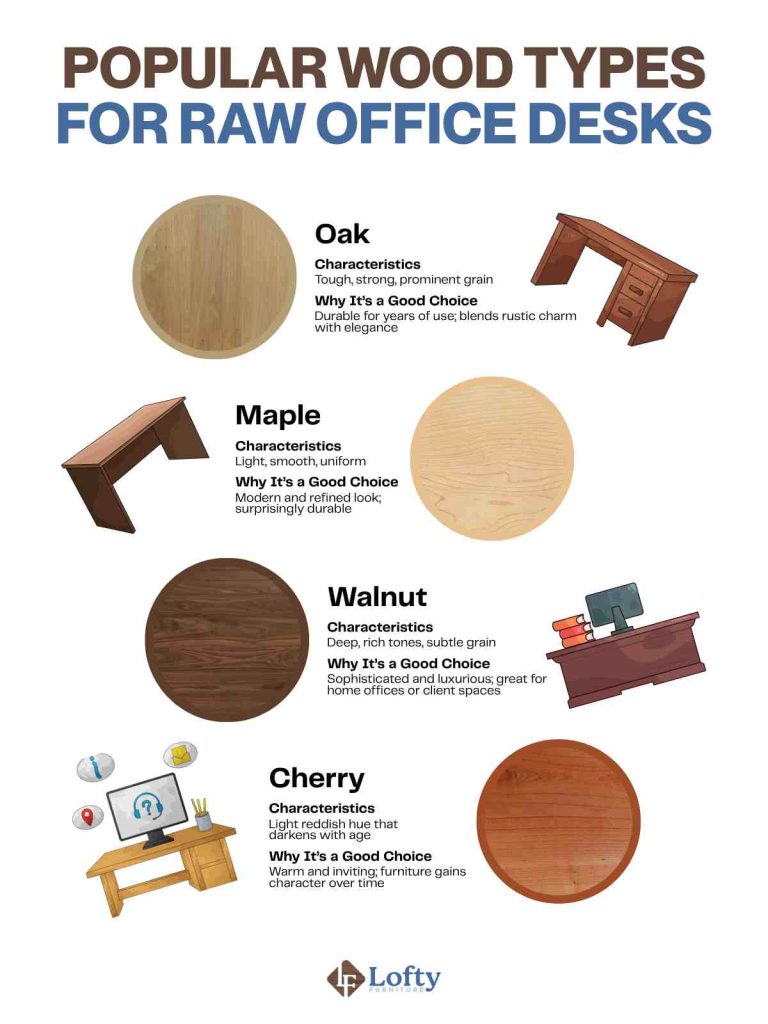
Why Choose a Raw Wood Desk?
Raw wood desks offer more than just a work surface; they bring natural elegance, durability, and character to any space. With their unique grain patterns and long-lasting strength, they stand apart from mass-produced alternatives, making them a smart investment for both style and functionality.
Sustainable and Built to Last
Raw wood office desks are both environmentally responsible and highly durable. When sourced from reclaimed wood or certified sustainable forests, they offer a lower-impact alternative to synthetic materials. Unlike particleboard or laminate, raw wood can last for decades, with the added benefit of being refinished over time. This makes it a smart investment that combines sustainability with long-term value.
Natural Beauty That Adapts to Any Style
Each raw wood desk has its own unique grain, texture, and color variation, bringing warmth and character to your workspace. Whether you prefer clean lines or a rustic edge, the natural material fits effortlessly into a wide range of interior styles—from modern and minimalist to traditional or industrial. Its timeless appearance ensures it stays relevant even as design trends change.
Designed Around You
Raw wood offers flexibility in both design and comfort. Many pieces can be customized in size, finish, and features, allowing you to create a desk tailored to your workflow and aesthetic. Beyond functionality, the natural material contributes to a calming environment by helping regulate indoor humidity and offering a tactile, grounded feel that supports focus and well-being.
Practical to Maintain
Despite its natural finish, raw wood is relatively easy to care for. Regular dusting and occasional oiling keep it looking its best, while minor wear can often be repaired with simple refinishing. Its ability to age gracefully—rather than wear out—makes it a practical, low-maintenance choice for anyone who wants both durability and style in their workspace.
Health and Psychological Benefits
Beyond aesthetics, raw wood can enhance your well-being. The natural material helps regulate humidity, improving air quality, while its tactile warmth creates a calming atmosphere that reduces stress and boosts focus. A workspace surrounded by natural elements and thoughtfully chosen workplace furniture.
Things to Consider Before Buying a Raw Wood Desk
A raw wood desk can be a standout addition to any workspace, but it comes with a few considerations that are worth understanding before you make the investment. From how it holds up over time to how much care it needs, here’s what to keep in mind.
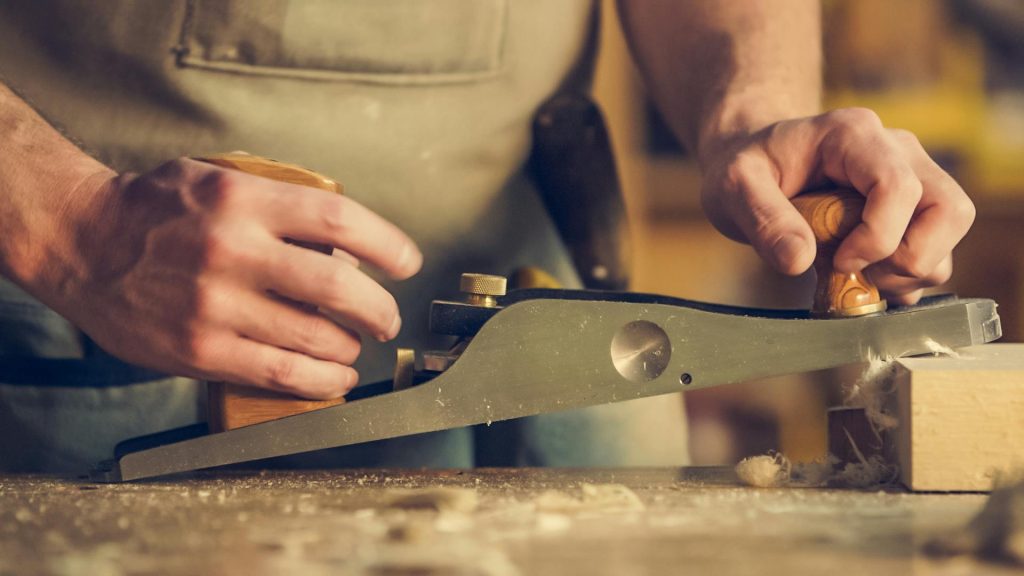
Choose the Right Type of Wood
The type of wood you choose plays a big role in how your desk will perform. Hardwoods like oak, walnut, and maple are strong, durable, and ideal for daily use. Softer woods, such as pine, are more affordable but tend to scratch and dent more easily. Reclaimed wood is another popular option—especially if sustainability and character are high on your list—though it may show more imperfections by nature.
Learn more about the differences between a hardwood vs. softwood.
Be Aware of Moisture and Movement
Because raw wood is untreated or minimally finished, it reacts to changes in temperature and humidity. This means it can expand, contract, or even warp if conditions fluctuate too much. If you live in a very dry or humid climate, it’s important to keep the desk in a controlled environment. Proper sealing helps protect the surface, but some natural movement is still to be expected over time.
It Requires Some Maintenance
One of the biggest differences between raw wood and manufactured desks is the level of care involved. You’ll need to oil or seal the surface occasionally to protect it from moisture and everyday wear. Light sanding might also be needed to smooth out minor scratches or refresh the finish. It’s not a high-maintenance routine, but it does require some attention to keep the desk looking its best.
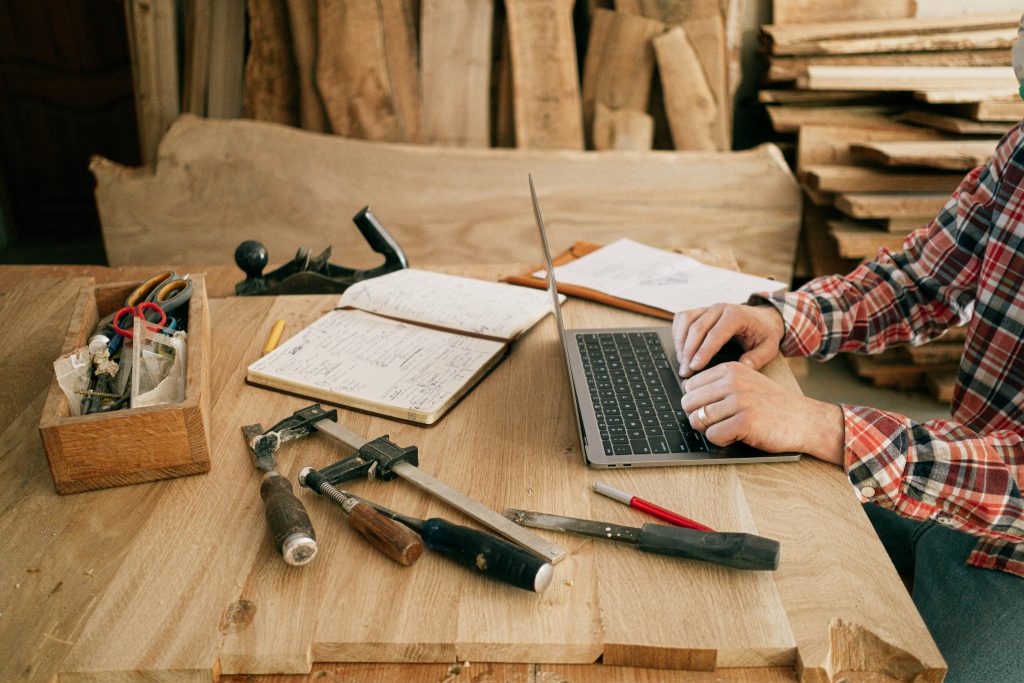
Consider the Size and Weight
Solid wood desks are often heavier and bulkier than their composite counterparts. This can be a factor when moving the desk or placing it in smaller spaces. Be sure to measure your room carefully and consider how the desk will be delivered or installed—especially if you live in a walk-up or plan to move it frequently.
Understand the Cost
Raw wood desks usually come at a higher upfront price. That cost reflects the quality of the materials, craftsmanship, and longevity you’re getting. While budget desks made from particleboard may be cheaper, they typically wear out faster and can’t be refinished. A well-made raw wood desk, on the other hand, can last for decades with the right care.
Check for Sustainable Sourcing
If sustainability is important to you, take a moment to ask where the wood is sourced from. Look for desks made from FSC-certified wood or reclaimed materials, which help support responsible forestry and reduce waste. Many makers and retailers are happy to provide this information, and it’s worth knowing your purchase aligns with your values.
Learn more about where to buy ergonomic Amish desks online.
Common Mistakes to Avoid When Buying a Raw Wood Desk
Choosing the right raw wood desk involves more than just picking a style you like. One common mistake is overlooking the size and fit because what looks great online might feel overwhelming or too tight in your actual space. It is also easy to underestimate your storage needs. While minimalist desks may look clean and modern, a lack of drawers or compartments can quickly become frustrating. Another pitfall is assuming all wood is the same. Softer or poorly treated wood can dent, scratch, or warp much more easily than high-quality hardwoods.
Finally, be cautious about sacrificing craftsmanship for a lower price. Desks built with cheaper materials or shortcuts in construction may not hold up over time. By avoiding these missteps, you will end up with a desk that not only looks great but also performs well and lasts for years.
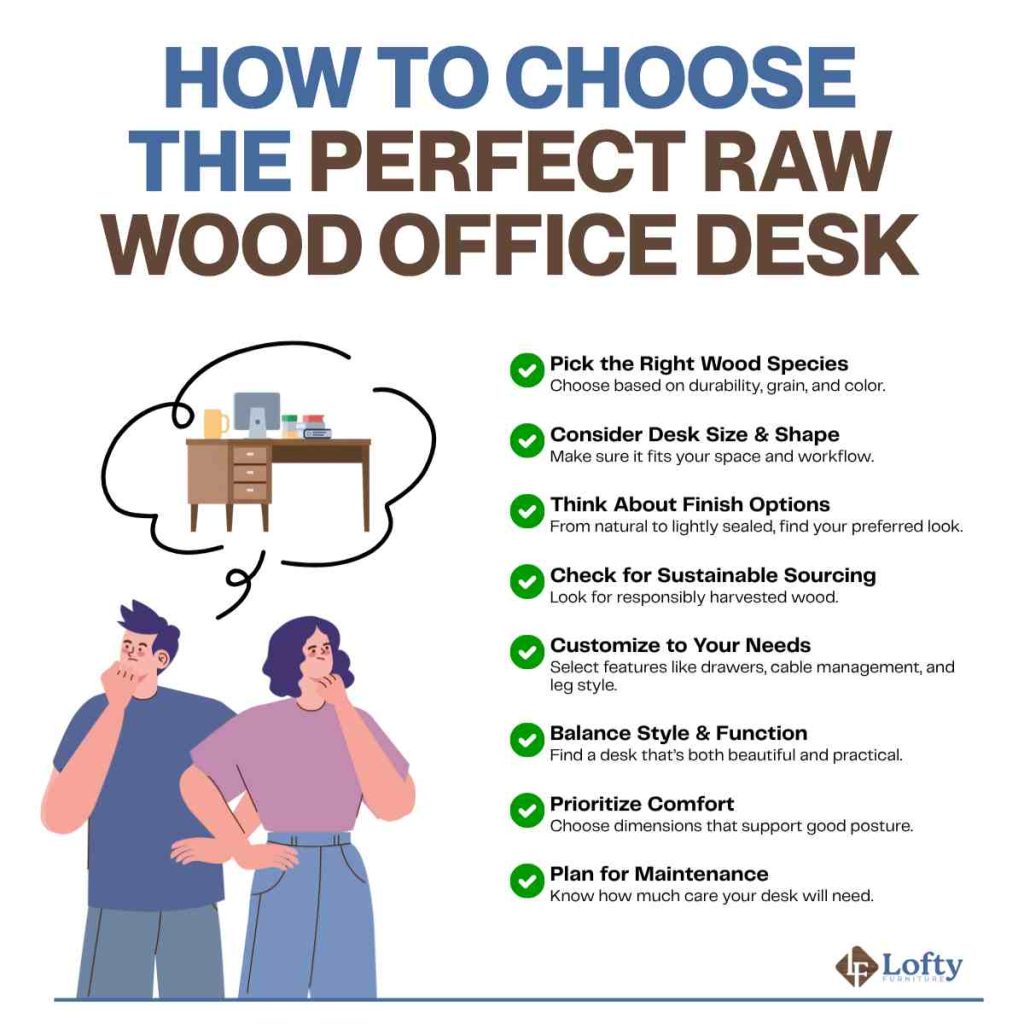
Discover Amish adjustable desks that combine durability and timeless style, perfect for your raw wood office setup.
Conclusion
Choosing a raw wood office desk is about more than just picking a beautiful piece of furniture. It is an investment in a workspace that supports your productivity, comfort, and style for years to come. With their unique grain patterns and natural warmth, raw wood desks bring character and authenticity that mass-produced options simply cannot match. They are durable and eco-friendly when responsibly sourced, and can be customized to fit your space and needs perfectly.
Just remember to consider the type of wood, maintenance requirements, size, and budget before buying to ensure your desk is a practical and lasting addition to your office. When chosen thoughtfully, a raw wood desk is not just furniture but a foundation for a workspace you will love every day.
Frequently Asked Questions
What kind of wood are cheap desks made of?
Cheap desks are often made from engineered woods like MDF (Medium-Density Fiberboard), particleboard, or plywood. These options are affordable because they’re made by compressing wood fibers or chips with glue. While they can mimic real wood with veneers or laminates, studies on MDF furniture boards show they lack the durability and longevity of solid wood.
Are desks made of MDF?
Yes! Many affordable desks are made from MDF. It’s smooth, easy to paint, and provides a uniform surface, which is why manufacturers use it for modern and budget-friendly furniture. However, MDF is heavier than particleboard and can sag over time if the desk isn’t properly supported.
Is MDF better than solid wood for desks?
It depends on your needs. MDF is cheaper, easy to shape, and resistant to warping, making it practical for budget-conscious buyers or desks with intricate designs. On the other hand, solid wood is far more durable, ages beautifully, and can be refinished multiple times, making it a better long-term investment if you want a desk that lasts for decades.
Can I combine solid wood and MDF for a desk to save money?
If budget is a concern, consider combining solid wood for the desktop with MDF or plywood for the frame. This gives you the look and durability of hardwood where it matters most, while keeping costs reasonable.
